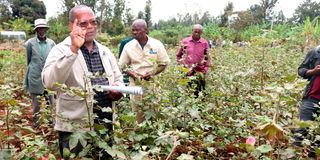Shortage of Bt cotton seeds grounds growing of the crop

Jesse Kariuki, a Bt cotton grower in Kirinyaga, with fellow farmers last week.
Jesse Kariuki’s farm which hosts Bt cotton was the centre of attraction last week after the government lifted the ban on farming and importation of genetically modified organisms.
Located in Kianjege village, Kirinyaga County, the farm attracted dozens of farmers growing the new variety of cotton.
Kariuki, a former tour guide who also farms bananas, avocados, coffee, maize and beans, has been growing cotton since 2018.
“I began with the conventional variety on two acres, investing Sh30,000, but I harvested losses due to drought, pests and diseases,” he said. “I only got six 50kg bags that I sold a kilo at Sh52 each.”
Having suffered losses, Kariuki was among the first farmers who embraced Bt cotton, which was approved by the government for commercial growing in 2019.
“Last April, I planted 930 stems of the new variety though I still have some 315 conventional plants. So far, the much I have spent on Bt cotton that I am harvesting currently is Sh2,500,” he said, noting the money went on land preparation and planting.
The farmer relies on rain to grow the crop but since he planted the crop, he said the area has only received rain twice but the Bt crop is still doing well.
“The new cotton variety is drought-resistant and still offers good yields,” said Kariuki during the event organised by the International Service for Acquisition of Agri-Biotech Applications (ISAAA) in partnership with Open Forum on Agricultural Biotechnology in Kenya (OFAB).
Despite being willing to grow the Bt cotton variety, farmers, however, lamented that accessing the seeds is a big challenge.
Kenya imports the Bt cotton seeds from India, which are then supplied to farmers through the Fibre Crops Directorate.
“We do not have seeds for the coming season, which starts this month because we have already harvested our crop,” Kariuki said.
Japhet Nteere, an officer from the Fibre Crop Directorate, attributed the delay to procurement procedures.
Cotton has two planting seasons every year, February-March during the long rain season and September-October for the short rains period.
To grow the crop, the land should be prepared well, levelled and soils have a fine tilth.
The crop is sown 60cm between plants and 100cm between rows. Each hole should host two seeds spaced at an interval of 4cm.
“One can either use DAP fertiliser or animal manure, preferably from goat that should be well-composted,” stated Kariuki.
After germination, the crop should top-dressed with fertiliser 60 days after planting.
Common pests in cotton are African or American bollworm, mealybugs and whiteflies.
“Bt cotton is genetically modified to be highly resistant to the African bollworm which has devastated the crop for a long time,” said Dr Paul Chege, a biotechnologist from ISAAA.
Diseases one should look out for include blight, cercospora and alternaria leaf spot.
“With the new variety, rounds of spraying to fight diseases have reduced drastically from 12 to about four until the crop matures,” Dr Chege said.
Another good agricultural practice that should be observed is frequent weeding. At early stages of flowering, petals are yellow then turn pink allowing formation of green ovalled shaped balls, which accommodate cotton.
The crop matures at the fifth month, with the balls splitting to pave way for the produce.
“Cotton is hand-picked and one should ensure it does not fall,” Kariuki advised, noting he sells his produce to a ginnery in Meru for Sh56 a kilo.
According to Dr Chege, a hectare of well-farmed Bt cotton can yield up to 1,400 kilos under irrigation, while rain-fed between 800 – 1,000 kilos.
“Realities of climate change are with us; unpredictable weather patterns, delayed and insufficient rains. Africa has suffered the most and we have to adopt crops that are highly resistant to the effects,” Dr Chege said.
Meanwhile, cotton farmers in Homa Bay are optimistic that the introduction of the genetically crop will revive the textile industry that collapsed in the county more than 20 years ago.
The county was the giant producer of the crop until mismanagement of cooperative societies led to collapse of ginneries.
Homa Bay County Cotton Cooperative Union chairman John Akoko said getting seeds has become a challenge.
"We got seeds that are not compatible with the climatic condition of our county. This led to low-quality produce which has less value at the market," Akoko said.
Union secretary Apiyo Oloo said more people are likely to join cotton if Bt cotton seeds are readily available.
Additional reporting George Odiwour.





